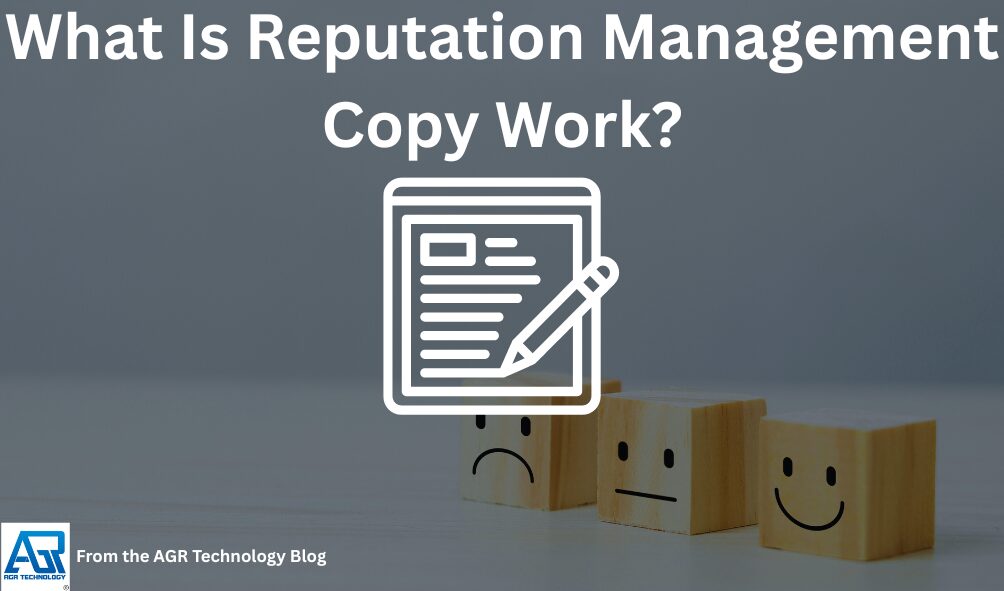If people “Google you” before they call, your words decide whether they trust you. Reputation management copy work is how we shape those words, on your website, listings, review replies, and social channels, so your best story is the one that’s easiest to find and believe. On this page, we explain what it is, where it shows up, how we approach it at AGR Technology, and how to measure it. If you’re ready to tighten your brand narrative and reduce risk, we can help.
Get in touch with AGR Technology to see how we can help build and maintain your brand
Definition And Core Purpose

Reputation management copy work is the deliberate planning and writing of short, high‑impact messages that protect credibility, clarify facts, and build trust across places where customers evaluate you. Think review responses, About pages, policy statements, help articles, and third‑party profiles. The copy is engineered to be accurate, empathetic, and searchable, so it answers doubts, defuses issues, and reinforces proof.
At its core, this work aims to:
- Reduce uncertainty: address common objections before they become complaints.
- Provide verifiable proof: highlight reviews, case studies, certifications, and policies.
- Maintain consistency: keep your voice and facts aligned across every channel.
- Minimise risk: respond to incidents without inflaming them, and document compliance.
We use this discipline to make sure your public footprint matches your real‑world standards.
How It Differs From PR And SEO Copy
- PR focuses on newsworthiness and media angles: reputation copy focuses on customer decision points and service recovery moments.
- SEO copy targets rankings at the page level: reputation copy targets trust signals across snippets, answers, and micro‑moments (reviews, FAQs, profiles). We still optimise, but truth and clarity come first.
- Outcomes differ: PR earns coverage, SEO drives traffic, reputation copy reduces friction and risk while improving conversions from the traffic you already have.
Online Versus Offline Contexts
- Online: Google Business Profile, knowledge panels, review sites, socials, help centres, emails.
- Offline: signage, in‑store policy language, printed disclosures, still part of the trust picture.
We write for both, so your message holds up anywhere a customer checks you.
Where Reputation Copy Shows Up
Reputation copy turns up in small but critical places. These are often the first or last words someone reads before making a decision.
Owned Channels: Website, Bios, Policies, And Responses
- About/Team bios: clean credentials, roles, and plain‑English expertise.
- Service and policy pages: refunds, privacy, warranties, SLAs. Transparent, compliant, and easy to scan.
- Help centre and status pages: incident write‑ups that explain what happened, impact, and fixes.
- Blog/Resources: “how we work” articles that answer real concerns, not fluff.
- Direct responses: email templates for complaints, escalations, and follow‑ups.
Earned And Shared Channels: Reviews And Social Replies
- Review responses: timely, empathetic, and factual. We acknowledge, offer a path to resolve, and avoid self‑incrimination.
- Social replies and DMs: short, human, and consistent with policy. No defensiveness, no debates in public.
- Community forums: pinned answers that close loops and reduce repeat issues.
Third-Party Profiles: Listings And Knowledge Panels
- Google Business Profile: services, attributes, Q&A, and updates aligned with real availability.
- Industry directories: complete data, categories, and proof points (awards, accreditations).
- Knowledge panels and FAQs: concise, citation‑friendly statements that search engines can trust.
If you’re unsure where to start, we can run a quick audit and prioritise the highest‑impact fixes first.
Key Elements Of Effective Reputation Copy
Voice, Tone, And Empathy
We match your brand voice while sounding human under pressure. That means:
- Plain language, short sentences.
- Acknowledging feelings without admitting fault prematurely.
- Owning verified mistakes and explaining next steps.
Evidence And Specifics: Social Proof, Data, And Receipts
Credibility comes from receipts:
- Verifiable reviews and testimonials (with context: job type, date, outcome).
- Case summaries with measurable results where possible.
- Certifications, audits, and policies linked from authoritative sources.
- Photos, videos, and changelogs that show, not just tell.
Clarity, Transparency, And Compliance
- No vague promises. We define scope, timeframes, and channels for support.
- We align copy with legal, regulatory, and industry standards (privacy, consumer law, accessibility).
- We avoid sensitive data and ensure secure, private escalation paths.
Done right, this copy de‑escalates tension and improves both perception and performance.
Crafting Process And Workflow
Audit And Message Mapping
We start with an audit across search results, reviews, socials, and your site. We map:
- Top questions and objections.
- Gaps, contradictions, and outdated claims.
- Proof assets you already have (and ones we need to create).
Then we build a message map: priority themes, approved phrasing, and do/don’t lines.
Response Frameworks For Reviews And Incidents
We use simple, repeatable structures:
- Positive review: “Thank + specific detail + reinforce value + subtle next step.”
- Mixed/negative review: “Acknowledge feeling + address the fact + offer remedy channel + invite continuation offline.”
- Incident post: “What happened + who’s impacted + what we did + how we’ll prevent it + where to get updates.”
Example (negative review):
“Thanks for calling this out, [Name]. We’re sorry for the delay. We’ve checked your order (#12345) and can ship today. If you’re open to it, please email support@… so we can confirm the address. We’ll follow up once it’s on the way.”
Approvals, Governance, And Templates
- Stakeholders: operations, legal/compliance, and marketing approve the map and templates.
- Guardrails: when to move from public replies to private resolution.
- Tooling: shared template library, tone notes, and examples. We keep it tight so your team can move fast without going off‑brand.
Want us to set this up for you? We can draft the full playbook and train your team.
Strategies For Common Scenarios
Responding To Negative Reviews Without Amplifying Harm
- Be timely, not reactive. Aim for same‑day acknowledgment.
- Stick to facts you can verify. Don’t argue opinions.
- Move to a private channel for specifics (order numbers, personal data).
- Avoid legal language unless legal is actually involved.
- Close the loop publicly once resolved: short, neutral, and appreciative.
Showcasing Positive Sentiment Ethically
- Quote real reviews with permission and context.
- Use rotating proof blocks across key pages (e.g., Google rating, case highlights).
- Encourage reviews after successful milestones, never incentivise falsely or filter.
- Let customers speak in their own words: we clean for clarity, not spin.
Addressing Misinformation And Crisis Moments
- Prepare a single source of truth (FAQ or status page) and link to it.
- Use consistent phrasing across channels: no contradictions.
- If a claim is false, state the verified fact and cite a credible source. Keep it short.
- In a true crisis, update on a schedule (e.g., hourly) until stable. Silence breeds speculation.
If you need hands-on help during a spike, our team can draft, approve, and publish under your governance within hours.
Measuring Impact And Iteration
Core Metrics: Ratings, Share Of Voice, And Sentiment
We track:
- Star ratings and review volume by platform.
- Response time and resolution rate.
- Sentiment trends in reviews, social mentions, and support tickets.
- Branded search impressions and click‑through rate on profiles and rich results.
- Conversion rate on key pages after trust copy updates.
Testing And Optimization Loops
- A/B test snippets: headers, bios, policy blurbs, and review reply styles.
- Monitor search features (FAQs, Q&A, knowledge panels) after copy changes.
- Update templates quarterly with new edge cases and language that performed best.
Conclusion
Reputation management copy work is the connective tissue between your operations and your public image. It turns messy moments into clear messages, and silent proof into trusted signals. If you want fewer escalations and more confident buyers, this is the work.
How AGR Technology helps:
- Rapid audit and priority roadmap.
- Message map, templates, and governance.
- Hands‑on drafting for reviews, profiles, and key pages.
- Ongoing testing and reporting.
Need a quick read on your current footprint? Request a free mini‑audit or if you’re ready to hand it off, contact AGR Technology to get a tailored plan and rollout timeline.
Frequently Asked Questions
What is reputation management copy work?
Reputation management copy work is the deliberate planning and writing of short, high‑impact messages that protect credibility and build trust wherever customers evaluate you. It covers review replies, About pages, policies, help articles, and third‑party profiles—crafted to be accurate, empathetic, and searchable so doubts are answered and proof is reinforced.
How is reputation management copy different from PR or SEO copy?
PR aims for newsworthiness and media coverage; SEO copy targets rankings at the page level. Reputation management copy focuses on trust signals in micro‑moments—reviews, FAQs, and profiles—prioritizing truth and clarity. The outcome is reduced friction and risk, with improved conversions from the traffic you already have.
Where does reputation copy show up online and offline?
Online, it appears on Google Business Profile, knowledge panels, review sites, social channels, help centers, and email. Offline, it includes signage, in‑store policies, and printed disclosures. The goal is message consistency across every touchpoint, so your public footprint matches real‑world standards in any setting.
How do you measure the impact of reputation management copy work?
Track star ratings and review volume, response time, and resolution rate. Monitor sentiment trends, branded search impressions, and profile click‑through. Check conversion changes on key pages after trust‑copy updates. A/B test snippets and review replies, then iterate templates quarterly based on what reduces confusion and escalations.
How long does it take to see results from reputation management copy work?
You can see quick wins within days—clearer responses and improved tone. Profile CTR and search features often shift in 2–4 weeks as listings and FAQs update. Sentiment and ratings trends typically stabilize over 1–3 months, depending on review volume, governance speed, and how consistently templates are applied.
Is reputation management copy worth it for small businesses?
Yes. Small businesses rely heavily on local search, reviews, and word‑of‑mouth. Strong reputation copy clarifies policies, responds empathetically to issues, and highlights proof like certifications and case results. That reduces objections, prevents escalations, and converts existing traffic more efficiently—without needing large ad budgets or complex PR campaigns.
Related resources:
Online Reputation Management Agency Australia
Online Reputation Management Agency USA
Online Reputation Management Agency New Zealand
Online Reputation Management Repair

Alessio Rigoli is the founder of AGR Technology and got his start working in the IT space originally in Education and then in the private sector helping businesses in various industries. Alessio maintains the blog and is interested in a number of different topics emerging and current such as Digital marketing, Software development, Cryptocurrency/Blockchain, Cyber security, Linux and more.
Alessio Rigoli, AGR Technology
![logo-new-23[1] logo-new-23[1]](https://agrtech.com.au/wp-content/uploads/elementor/thumbs/logo-new-231-qad2sqbr9f0wlvza81xod18hkirbk9apc0elfhpco4.png)
